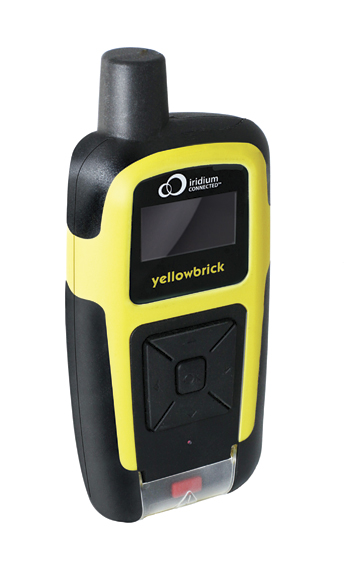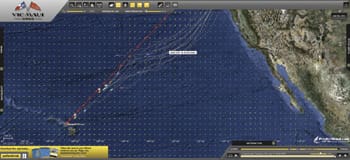For race committees and family and friends on shore, tracking and communicating with boats in an ocean race has certainly evolved. It the past, boats would leave soundings and largely disappear until reaching the finish line. Now, folks ashore can see every tack on Web-based tracking charts. In addition to tracking devices, race committees are using satellite phones and investigating other satellite-based techniques to stay in contact with racing fleets.
As this is written in mid-July, the Victoria-Maui Race is underway. For the Vic-Maui Race, like many ocean and coastal races, the tracking is done via the Yellowbrick Tracking service. Every boat is equipped with a Yellowbrick tracker package. Nick Farrell, director of Yellowbrick, said the tracker unit needs no outside connections.
“Basically everything is in that one unit — all antennae, battery, everything.” Farrell said. “All the boat needs to do is strap the unit onto the stern rail — for rental we put them in a quick-to-fit pouch with strong velcro straps — and that’s it. No external antennae, nothing to plug in.”
 |
|
Every boat in the Vic-Maui Race is equipped with a Yellowbrick tracking unit. |
The unit has a built-in GPS that determines the vessel’s position then it transmits that position via Iridium low earth orbit satellites to an Earth station and then to Yellowbrick’s servers.
“Both the Iridium and GPS antennae are inside the unit,” Farrell said. “The tracker wakes up at predefined times, like every 30 minutes, and will get a GPS fix. It will then transmit that message via Iridium satellite, which we receive, decode, and display on the map.”
The position data is integrated with position data from other race vessels and then presented on a chart of the race course with each vessel represented by a different color. The Yellowbrick application has some great features so that each race fan can customize the view. You can zoom out to see the entire race course or zoom in to see the tactical situation of just a few boats. You can toggle on/off a variety of view items: the lat/long grid, turn on the day/night line, show the rhumb line, show wind arrows, show boat tracks.
The Yellowbrick display also allows you to replay the tracks up to that point of all the boats involved in the race. And you can set the speed of the replay. This feature is great right after the race has finished and you want to watch how the race progressed from beginning to end.
And, of course, knowing the positions of vessels offshore has ramifications for safety. “When something goes wrong such as an abandoned boat or capsize, etc., Farrell said, “we can remotely change the transmission times from the tracker to get more frequent position reports for example — helpful for rescue.” Farrell says, however, that Yellowbrick is not a safety device. “We don’t sell this service as a safety device — it isn’t for that. That is EPIRB territory. The EPIRB is the first point of call for any emergency offshore.”
The Yellowbrick tracking service is widely used by race committees. In addition to the Vic-Maui and Newport Bermuda races, Yellowbrick is used by the Sevenstar Round Britain and Ireland Race, the Velux 5 Oceans, the Global Ocean Race, the Chicago Race to Mackinac, and others. In all, the Yellowbrick service is used in roughly 120 races around the world each year.
Race tracking is one part of the puzzle. Another is communications setups that allow a race committee to talk with offshore race boats and vice versa. The biggest reason for this type of communication is safety. When a situation develops on the race course, there is a need to communicate with the boat experiencing the emergency, but also to talk with nearby vessels so they can change course to render assistance.
A textbook example of this is the recent Newport Bermuda Race. One of the racers, Nathan C. Owen of the 46-foot sloop Seabiscuit, had a medical problem. Barbara A. Masser MD, associate director of the department of emergency medicine at Beth Israel Deaconess, in Needham, Mass., the doctor consulting for the race committee, recommended that Owen receive immediate treatment.
News of this development was facilitated by a team of volunteer watchstanders. As described by John Rousmaniere on the Newport Bermuda website, the watchstanders are a key link in the communications chain: “Throughout the race, seven experienced sailors take turns in four-hour watches to monitor the races tracker and communications. These watchstanders alert the race committee, Bermuda’s Rescue Coordination Center, and other services when problems appear.”
Dr. Masser suggested that Owen be treated for dehydration while still aboard Seabiscuit and Race Communications Chairman and watchstander Steven Thing requested that Flying Lady, the race boat with a doctor on board nearest to Seabiscuit, rendezvous and be ready to help. Thing later also asked the sail training schooner Spirit of Bermuda to turn and sail 78 miles back to Seabiscuit. Ultimately, a cruise ship took Owen on board and brought him to Boston where he fully recovered.
The Vic-Maui Race takes a similar approach to communications. “Communicating with the fleet is primarily by SailMail,” wrote Michael Wealick, race communications director, in an e-mail. “Daily roll call is at 1800 HST with position updates. If important, boats can be e-mailed directly as all boats have single sideband radio or satellite phone capability. Most (not all) boats carry a satellite phone for emergency. Emergency communications can also go through the U.S. Coast Guard.”
These communications were performed via HF SSB and satellite phone. Looking to future races, it might be possible to take a page from what amateur radio operators have already done and use satellite transponders to communicate with race boats via VHF channel 16. With such a satellite-based system, race boats could use their existing VHF radios to communicate with the race committee ashore by using satellites to relay the signal.

